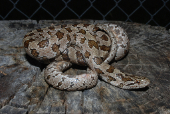Prairie Kingsnake (Lampropeltis calligaster)
Description: It is light brown or grey in color, with dark grey, dark brown, or reddish-brown blotching down the length of their bodies. They are capable of growing to lengths of 30 to 40 inches. They are easily mistaken for various species of rat snake of the genus Pantherophis, which share habitat, and can have similar markings. Some specimens have their markings faded, to appear almost a solid brown color. Juveniles usually have a brown stripe down the back of their bodies. They have two black spots behind the head and smaller black spots down the back on both sides of the stripe.
Habitat: They are often found in abandoned structures, underneath logs, debris, and inside of tree trunks. They are typically unseen by people not searching for them due to their secretive nature. The mole kingsnake is fossorial as their name would suggest. However, when they are found aboveground they are found in open areas such as fields, cultivated lands, thickets, and edge habitats.
Range: Prairie kingsnakes are found mostly in the midwestern and southeastern United States although they can be found in other areas. Their additional range extends west from southeast Nebraska to eastern Texas.
Diet: Prairie kingsnakes are omnivores with a primary diet of mice, amphibians, snakes (including other prairie kingsnakes), lizards, birds, and bird eggs They also occasionally eat insects. Young prairie kingsnakes more often consume reptiles and small frogs compared to older prairie kingsnakes. They are active hunters, so they more commonly eat warm-blooded prey.
Reproduction: Prairie kingsnakes typically breed once a year, but there have been reported occasions of multiple egg clutches for this species. Mating begins in early spring, around April. At the southern extent of the range, south Florida mole kingsnakes begin mating as early as March. Egg-laying occurs in June and July and hatching in August and September. Prairie kingsnakes are iteroparous, reproducing multiple times throughout their lives.
Prairie kingsnakes of both sexes reach sexual maturity at 1 to 4 years of age. Most prairie kingsnakes breed at 32 months. Prairie kingsnakes have induced ovulation during copulation. Eggs becomes internally fertilized by sperm.
Gestation time in prairie king snakes has not been reported. Their incubation period ranges from 50 to 70 days (average 62 days). One to 6 slits appear in the top of the egg prior to hatching. The number of offspring ranges from 5 to 17 (average 10). The newly-hatched snakes typically have a snout-vent lenth of 234 to 308 mm. The birth mass ranges from 6.0 to 12.2 g (average 9 g). Hatchlings are precocial (independent at birth) and have similar markings to those of adults. The clutch weight is an average of 38% the post-ovipositional weight of the female that laid the eggs.
Status: Listed as Least Concern in view of its wide distribution, tolerance of a degree of habitat modification, presumed large population, and because it is unlikely to be declining fast enough to qualify for listing in a more threatened category.
»» Kingdom: Animalia - Animals
»» Phylum: Chordata - Chordates
»» Subphylum: Vertebrata - Vertebrates
»» Class: Reptilia - Reptiles
»» Order: Squamata - Scaled Reptiles
»» Suborder: Serpentes
»» Superfamily: Colubroidea
»» Family: Colubridae - Colubrids
»» Genus: Lampropeltis
»» Species: Lampropeltis calligaster - Prairie Kingsnake
This article uses material from the Wikipedia article "Lampropeltis calligaster", which is released under the Creative Commons Attribution-Share-Alike License 3.0. Content may have been omitted from the original, but no content has been changed or extended.
|













